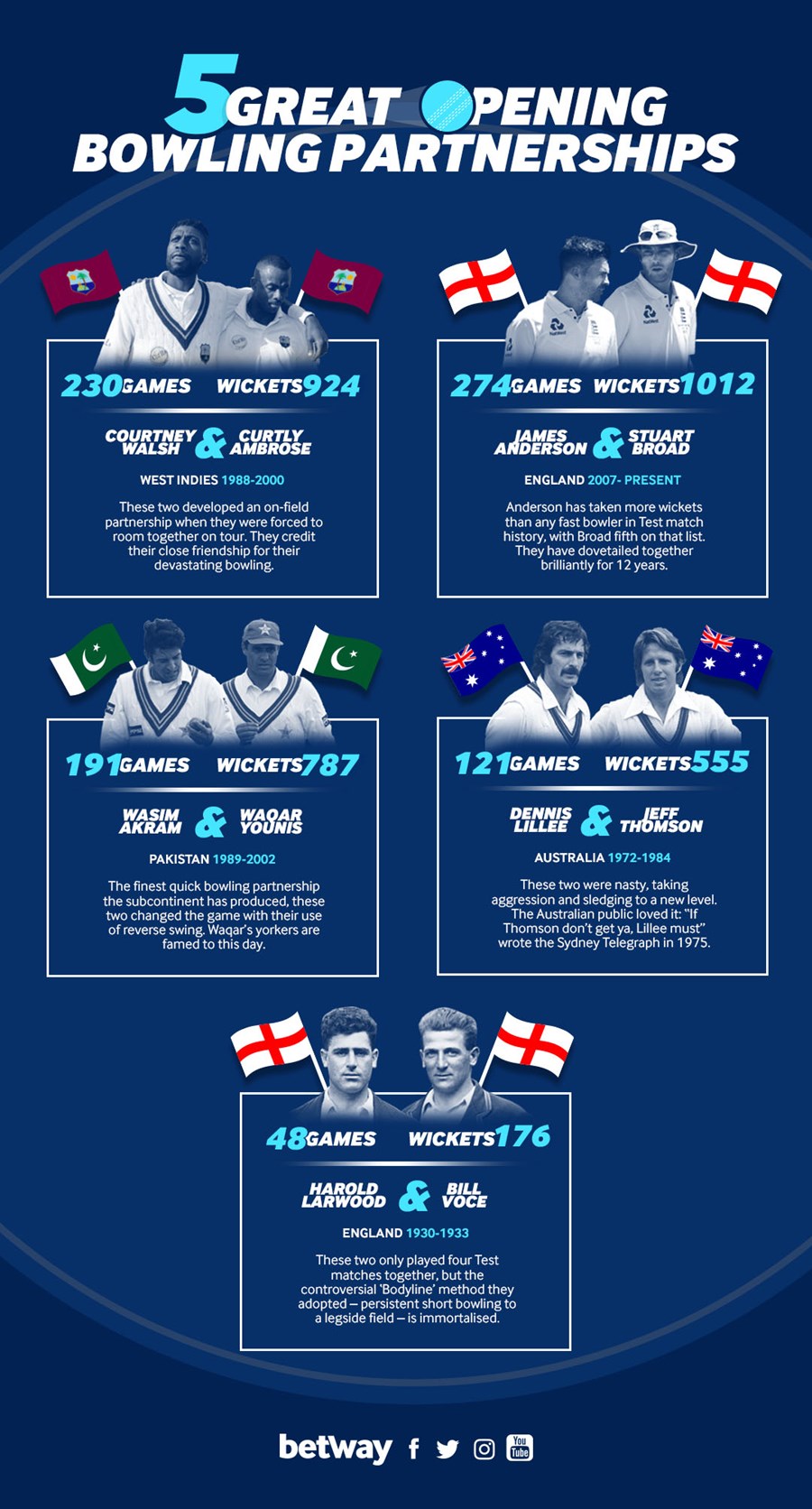Walsh and Ambrose on what makes a great bowling partnership

With Jimmy Anderson and Stuart Broad set to play in their last Ashes series, two West Indies legends reveal the secrets to success for a new-ball duo.
Given their bowling partnership was famed for aggression and intimidation, Courtney Walsh and Curtly Ambrose are remarkably relaxed about how they are remembered.
“As part of the fast bowling fraternity, and very passionate about it, I love to see fast bowlers doing well,” says Ambrose, when asked how he feels about his modern-day successors.
“For me, it’s a pleasure to see bowlers doing better than former greats.”
“What Jimmy [Anderson] and Stuey [Broad] have done for the game, for example, is tremendous,” says Walsh. “Hopefully another partnership will come along that will be even better.”
It was always this way. Both are sincere when they talk about how they were never invested in their own egos or legacies.
“If I take 10 wickets in a Test match and we lose it’s a waste of time,” says Ambrose. “I love winning, winning is a nice feeling. I don’t take losing very well.”
Fortunately, that was never much of a problem.
Between 1988 and 2000, only Australia - to win the 2019 Ashes in the latest cricket betting - won more Test matches than the West Indies. Their win-loss ratio was also second-best until the end of 1995, when the standard of the team around them began to decline.
Walsh and Ambrose played a combined 230 Test matches, with their individual wicket-taking tallies – 519 for Walsh and 405 for Ambrose – adding up to 924 overall.
They opened the bowling together in 52 Test matches, sending 412 batsmen back on their way. Only two new-ball partnerships have managed more scalps.
“I think we set the bar,” Walsh says. “History will tell you that our records were broken, but it’s good to be able to say that.
Were it not for a couple of twists of fate, though, the pair might never have even met.
“From a young age I used to bowl with much older guys, but cricket wasn’t my love,” says Ambrose.
“My first love has always been basketball, followed by football. Cricket was third in line.
“Fortunately, my mother – who is a cricket fanatic – wanted a cricketer in the family. She was the driving force, and deserves all the credit for getting me into cricket.”
Walsh also nearly headed down a different path.
“Originally when I started I was a spinner,” he says. “I did everything to spin the ball.
“But there was this concrete strip at Melbourne Cricket Club in Jamaica, where Michael Holding used to play, and I used to run in and bowl fast on that. That’s where it all started.”
Walsh eventually broke into the West Indies team as a fast bowler in 1984, and was united with Ambrose four years later.
Initially, the pair had little to do with each other. But the on-field chemistry began to blossom once they were forced to spend more time together off the field.
“Our partnership didn’t start from when I made the team,” Ambrose says.
“In 1990 we became roommates, and that is when we learnt a lot more about each other and our friendship really started.”
“We’d have good nights where we’d have dinner together, we’d chat, we’d discuss other things than just cricket,” Walsh says.
“It helped us to understand each other, and how we each thought about things.”

So followed a partnership that would set the benchmark for all to follow.
Of the three new-ball partnerships to take over 400 wickets, Walsh and Ambrose beat the others to the post, reaching the milestone before Wasim Akram and Waqar Younis of Pakistan and England’s Anderson and Broad.
“There is no secret or magic to it,” Ambrose says.
“If he [Walsh] was taking wickets, then my job was simply to make sure I kept the same pressure from the same end. If it was my day, he’d do the same.”
“We looked after each other,” says Walsh.
“I would look to him from the boundary and tell him what I had seen or what I had noticed. And he would do the same for me.
“The best partnerships complement each other, but don’t compete against each other.”
The competitive juices must occasionally have been flowing, though?
“Yeah, we would always have a smile, seeing who was going to get the most wickets that day,” says Walsh. “But it was a jovial thing.”
“Curtly was the sort of guy who said, ‘Let’s see who can do things first.’”
Walsh can lay claim to the ultimate prize. He describes the moment when he became the first bowler to take 500 wickets in Test cricket as the highlight of his career.
Yet Ambrose emphatically won the pair’s daily competition when he took 7-1 in one spell against Australia in January 1993; “a really freakish moment – something that is unheard of”.
The pair’s relationship was put to the test in 1994, when Walsh replaced Richie Richardson as the West Indies captain, potentially adding an awkward dynamic to the relationship.
Fortunately, Ambrose’s sense of fun ensured that the transition was painless.
“When Courtney became captain, I still had choice of ends,” he says. “So of course I always said to him, ‘I’m going to choose the end with the breeze at my back, and you’ve got to bowl into the wind’.
“He’s a joker, so he said, ‘Man, I’m the captain and you’re still ordering me around’. It never turned into a problem.”
Ultimately, Walsh and Ambrose had a common goal that would always extinguish any personal tension.
“One of the highlights of the West Indies team was that we cherished everybody’s company,” says Walsh.
“It was a tremendous effort all round – every time you looked at that particular team you’d think, ‘Wow’. What we did was what the team required first and foremost.”
As Anderson and Broad prepare for what will surely be their final Ashes series as a pair, the greatest fast bowling partnership of all time will be heavily debated.
Walsh and Ambrose will be right in the mix, but they won’t really care about the conclusion.




































